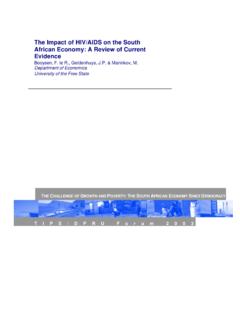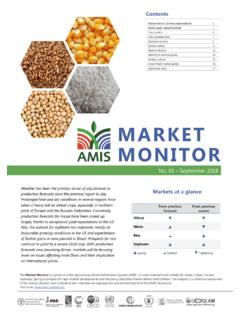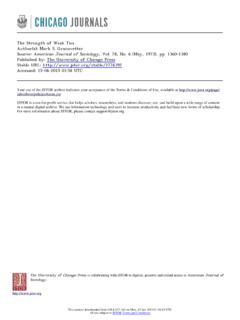Transcription of Part 1, chapter 2. Agriculture in Sub-Saharan Africa ...
1 OECD-FAO Agricultural Outlook 2016-2025 OECD/FAO 201659 PART IChapter 2 Agriculture in Sub-Saharan Africa : prospects and challengesfor the next decadeThis chapter reviews the prospects and challenges facing the agricultural sector inSub-Saharan Africa over the next decade. It reviews sector performance, outlinesthe current market context, provides detailed quantitative medium term projectionsfor the ten-year period 2016-25, and assesses key risks and uncertainties. Theoutlook for Agriculture in Sub-Saharan Africa is situated in the context of severalmega-trends that shape the sector s development.
2 These include rapid populationgrowth, urbanisation and rural diversification, an associated structuraltransformation from farm to non-farm employment, a growing middle class, andincreasing interest (both domestically and globally) in the continent s farmland. TheOutlook for Agriculture is broadly positive, but could be further enhanced byconsistent policies and strategic investments, in particular in rural statistical data for Israel are supplied by and under the responsibility of the relevant use of such data by the OECD is without prejudice to the status of the Golan Heights,East Jerusalem and Israeli settlements in the West Bank under the terms of international position of the United Nations on the question of Jerusalem is contained in General AssemblyResolution 181(II)
3 Of 29 November 1947, and subsequent resolutions of the General Assembly andthe Security Council concerning this Agriculture IN Sub-Saharan Africa : prospects AND CHALLENGES FOR THE NEXT DECADEOECD-FAO AGRICULTURAL OUTLOOK 2016-2025 OECD/FAO 201660 IntroductionThe Sub-Saharan Africa1(SSA) region accounts for more than 950 million people,approximately 13% of the global population. By 2050, this share is projected to increase toalmost 22% or billion. Undernourishment has been a long-standing challenge, withuneven progress across the region. Despite being reduced from 33% in 1990-92 to 23%in 2014-16, the percentage of undernourishment remains the highest among developingregions (FAO, IFAD and WFP, 2015).
4 Owing to rapid population growth of over thesame period, the absolute number of undernourished people has increased by 44 million toreach 218 million. Slow progress towards food security has been attributed to lowproductivity of agricultural resources, high population growth rates, political instabilityand civil strife. However, vast regional differences remain and the success achieved incountries with stable political conditions, economic growth and expanding agriculturalsectors suggests that appropriate governance systems, institutional capacities, and macro-economic, structural and sectoral policies can work together to improve food security on along-lasting and sustainable important role of the agricultural sector in contributing to food security isreflected in its prioritisation in the development agenda.
5 The Comprehensive AfricanAgricultural Development Programme (CAADP) is an integral part of the New Partnershipfor Africa s Development (NEPAD) and the sector s prominence in the region is evident inits contribution to total GDP, which is generally high in the global context. The highcontribution of the agricultural sector to GDP also underlines the limited diversification ofmost African economies. On average, Agriculture contributes 15% of total GDP, however itranges from below 3% in Botswana and South Africa to more than 50% in Chad (Figure ),implying a diverse range of economic structures.
6 Agriculture employs more than half of thetotal labour force (IMF, 2012) and within the rural population, provides a livelihood formultitudes of small-scale producers. Smallholder farms constitute approximately 80% ofall farms in SSA and employ about 175 million people directly (Alliance for a GreenRevolution in Africa , 2014). In many of the countries, women comprise at least half of thelabour force (FAO, 2015).Given its role in confronting the challenge of eradicating hunger and improving foodsecurity, this chapter considers the historic performance and current state of Agriculture inSSA, within the context of the region s political and economic conditions, natural resourcesituation and demographic structure.
7 It acknowledges the role of policies and megatrends2in shaping development of the agricultural sector. Megatrends include demographicchange, the rise of the African middle class, growing access to new information andcommunication technologies, rapid urbanisation and consequent shifts in food is accompanied by downstream modernisation of food systems, a considerable shiftin the labour force from farming to nonfarm jobs, and rising global interest in availableAfrican farmland strengthened by the sharp rise in agricultural commodity prices over thepast Agriculture IN Sub-Saharan Africa .
8 prospects AND CHALLENGES FOR THE NEXT DECADEOECD-FAO AGRICULTURAL OUTLOOK 2016-2025 OECD/FAO 201661 These megatrends are not inevitable and remain subject to a degree of uncertainty aswell as future policies. The focus on SSA as a whole risks perpetuating a view of Africa asa single entity, however this chapter aims to provide an agricultural outlook, with a widerconsideration of links to growth and food security, that reflects the complexity within agricultural environment in Sub-Saharan AfricaAfter decades of stagnation, much of Africa is now experiencing rapid economictransformation.
9 In the post-structural adjustment period, the business environment hasbecome more stable and albeit from a small base, the region has experienced rapideconomic growth since the mid-1990s. These domestic factors in combination with theglobal commodity boom enabled commodity exporting countries in particular to achievegrowth rates above or near 6%. However, the recent decrease in agricultural commodityprices, lower demand arising from China and currency depreciation have tempered growthrates in African economies. Foreign investment and external financial flows into Africahave quadrupled since 2000.
10 These flows are expected to increase further in the comingyears (AfDB, OECD & UNDP, 2014),3whileinternallygeneratedfundsinth eformoftaxrevenues continue to rise across the of agricultural growthEvident from its high share in GDP (Figure ), the prospects of the agricultural sectorheavily influence economic development in most countries in Sub-Saharan 1990 to 2013, the total value of agricultural production, measured in constant USdollars, increased by 130% (Figure ). The crop sector dominates total agriculturalproduction value, accounting on average for almost 85% of total production value over the24-year period.


















